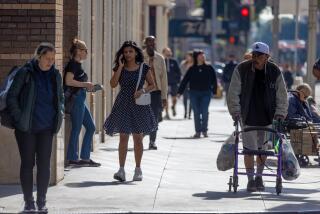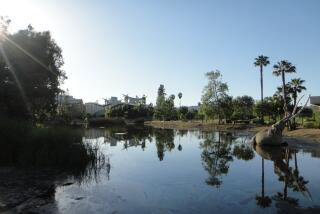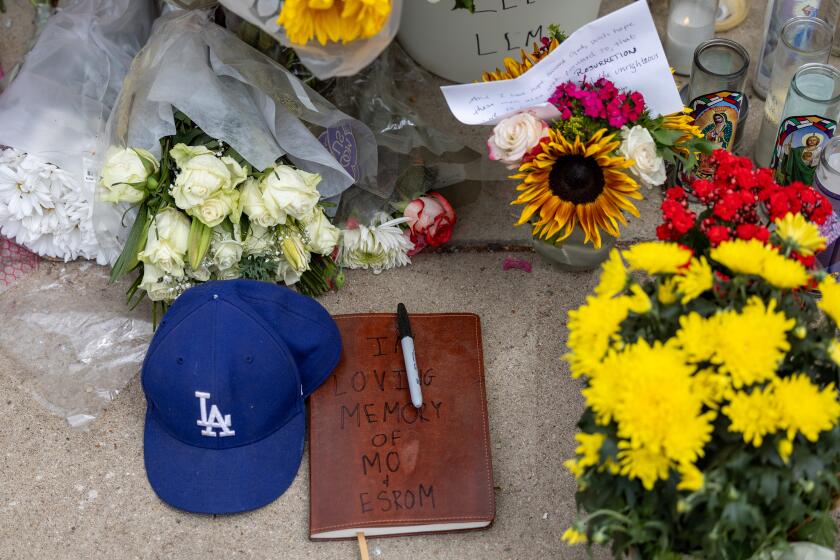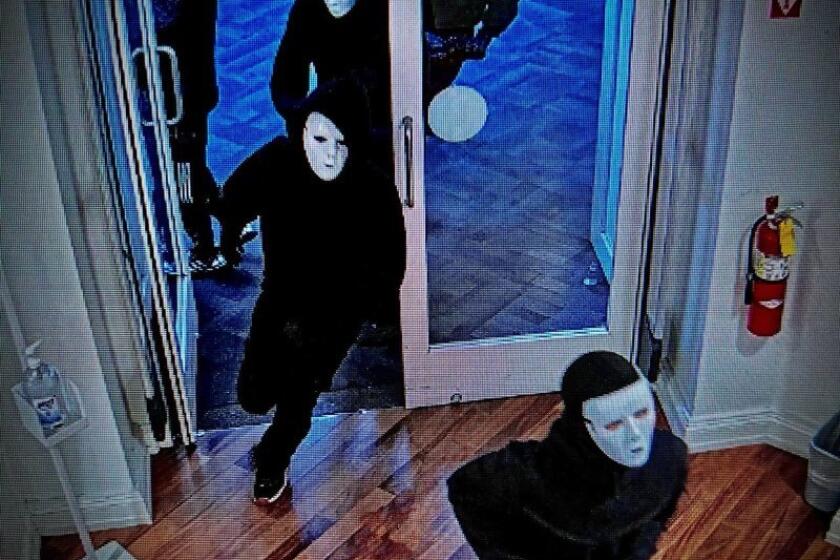Sleepy Barrio May Be About to Awaken : Carlsbad: The barrio has suffered from benign neglect while the city prospered. Now that may change.
Coming home to the barrio after 26 years, Ofelia Escobedo beheld a sight that seemed to defy the laws of time.
There, as if by some astonishing act of suspension, the rickety little houses and worn streets of Carlsbad’s Latino quarter appeared virtually unchanged since Escobedo had first seen them in 1943.
Many people she knew long ago still lived there, older but still proud. As always, the laundry fluttered from clothes lines in the ocean breeze. Spanish rolled along the sidewalks as the true language of friends and neighbors.
“I was gone all those years and I came back and the barrio was just the same,” mused Escobedo, a gentle, soft-spoken woman who owns a small corner market and deli--a gabby meeting place for the neighborhood--with her two sisters.
But she and a group of like-minded people have no intention of letting the barrio of roughly 4,529 people living in 1,281 dwellings remain trapped in the past, certainly not while the rest of Carlsbad enjoys wealth and reputation.
Just north of the barrio, a 10-year city redevelopment program has dusted off a once-dingy downtown and made it a showpiece of specialty shops and restaurants called “The Village.”
“It does look nice up there,” Escobedo’s sister, Connie Trejo, said wistfully, as though “up there” was a distant mountaintop.
To the west, beyond the lonely railroad tracks, is the beach, the city’s graceful seawall, expensive houses with sweeping ocean views and vacation time shares that draw thousands of tourists annually to Carlsbad.
But the barrio has somehow missed being part of the city’s attainments, and finally, Escobedo has assembled a cadre of 25 people to demand that the barrio share a piece of the dream.
They have visions of freshly painted barrio homes, neat yards, ugly utility polls and wires put underground, and colorful Mexican shops that will hold cultural appeal to people for miles around.
Some city officials agree the barrio’s time has come, and the City Council will soon decide whether to explore creating a new redevelopment area for the barrio, bounded by Elm Avenue to the north, Interstate 5 to the east, Tamarack Avenue on the south, and the railroad tracks.
“There are some incredible opportunities to create specialized retail, Olvera Street, if you will,” said city Housing and Redevelopment Director Kathy Graham.
Yet while the barrio has its first glimmer of optimism, there is also an awareness that once begun, progress could go far beyond what the people there have in mind now.
After all, the barrio is desirable property in central Carlsbad and near the coast, raising some concern that ultimately, land speculators could take the barrio away for other uses.
“One of these days, it will all be Japanese in here,” said 57-year barrio resident Joe Mercado, referring to foreign investment.
Still, the mere discussion of what the barrio could become is a bold departure from what it has been since 1916, when refugees from the bloody revolution in Mexico began settling in tents and tiny frame houses.
The area became known as Barrio Carlos, and in recent years it has also become home to migrant farm workers as well as escapees from unrest in San Salvador and Honduras.
But in earlier times, the Mexicans and their American-born children worked in the corn and bean fields, and some owned shops in the little downtown. Carlsbad was about 1,500 people then, compared to 63,000 today, and the barrio was surrounded by the sprawling ranches of wealthy Anglos.
Joe Mercado’s wife, Ernestine, 82, came here in 1924. Her father, who had lost one arm, sold the family’s 80 acres in Arizona, believing life would be easier in California. Property in Carlsbad was selling for $50 a lot, Ernestine Mercado said.
Latinos and Anglos had a rapport, attending the same schools and dances but living in separate parts of town. “We didn’t have any problems. We all got along and became friends,” she said.
But as the years passed, Carlsbad evolved into an upscale coastal community where the median price of a home is $266,000 and the median family income in 1988 was over $41,000.
The barrio was simply overlooked as the city pursued its destiny. “We had so many things to do, the downtown (redevelopment), the sea wall, the suburbs, the area just went to sleep,” said City Councilman John Mamaux.
“Now is the time to do something,” he said.
About the only thing happening in the barrio these days almost looks like an apparition. Amid the blocks of modest single-family homes, Jesse Johnston with his own hands is building an attractive, two-story shingle home along vague Victorian lines.
When it is done, his father, who is in his 80s, will make it his retirement home.
“I’ve been working on this for almost four years, and not much has happened” elsewhere in the neighborhood, said Johnston. The house is such a curiosity, that two or three barrio residents stop by each day to inquire about it.
“I get that a lot--’What the hell is this guy doing here? He’s over-building,’ ” Johnston said.
Generally, and despite the barrio’s choice location, there’s been little to entice investors and new development over the years. That’s because the typical lot is small and land prices aren’t bargains.
“Most of those lots, all you can do is put another single home on them,” said real estate expert Bob Nielson of Nielson Associates. He said it’s difficult to buy up enough contiguous lots to make room for a project because so many barrio residents never sell and move on.
“I’ll tell you, they’ve been there 30, 40, 50 years. They’re going to stay there ‘til something happens to them,” said Nielson. Most lots only change hands when the long-time owners die, leaving the property to their children, who usually sell.
“The barrio’s got to change,” Nielson said.
That suits Escobedo just fine.
Her parents moved to Carlsbad in 1943 and opened a little grocery store across the street from the one Escobedo and her two sisters own now, Lola’s Market. She left in 1953, worked for McDonnell-Douglas for 22 years in Orange County, and returned to the barrio in 1979.
During her long time away, “I came to understand the Anglo world of politics. . . . I used to be very quiet, didn’t want to make waves. But I’m older. I don’t mind ruffling feathers,” she said.
In her low-key way, she’s spread the gospel of barrio betterment, drawing together a group of activists and getting the ear of City Hall. Mayor Bud Lewis and Assistant City Manager Frank Mannen have stopped by the market to see her. She’s spoken to redevelopment chief Graham.
The barrio’s decades-old political slumber has ended.
Escobedo said residents had felt “anger they (the city) hadn’t really tried to come down here and help us.” But, she added, “some of it is probably our fault because we don’t speak up. We didn’t go to City Council. We waited for them to come to us.”
It’s too soon for a clear picture of what a redevelopment district could do for the barrio. Under redevelopment, money for projects is taken from property taxes. If approved by the council, it would take a year to establish a redevelopment area.
“We’d like to develop something that continues our Mexican heritage,” Escobedo said.
For Graham, redevelopment could include opportunities to create jobs by stimulating new commerce, rehabilitate old housing, bury utilities underground and buy land to provide affordable housing.
The barrio, she said, “is level, close to the beach and close to downtown shopping. It now needs to be revitalized.”
Graham added, “the cultural element is unique. To share it with the whole community is very appealing.”
Not all redevelopment-minded Latinos live in the barrio.
Manny Valdez belongs to the new generation. His parents still reside in the barrio, but Valdez, a 41-year-old financial consultant, moved to a newer part of Carlsbad.
“All the kids have gone, the parents are the ones who are permanently down there now,” he said. He believes it’s fated by simple economics that eventually, the barrio will change--as he put it, “the money’s going to happen.”
While Valdez personally has no emotional attachment to the barrio, he is working with Escobedo to make sure redevelopment helps preserve and enhance his parents’ lives.
“I want to make sure my parents, my cousins, the friends I grew up with, get a fair shake,” Valdez said. “If people who’ve lived there 40-50 years want to stay there until they die, let’s help them.”
More to Read
Start your day right
Sign up for Essential California for news, features and recommendations from the L.A. Times and beyond in your inbox six days a week.
You may occasionally receive promotional content from the Los Angeles Times.






